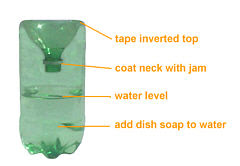 |
| Hornet |
 |
| Bee |
 |
| Wasp |
Late summer/early fall is prime time for stinging insect activity. Unfortunately, it's also a popular time for picnics, campouts, backyard barbecues and family reunions. Combine the two types of activity and you've got a recipe for annoyance, pain and discomfort.

According to allergist, Dr. Barry Rhoades, most everyone has some form of allergic reaction to insect stings with reactions ranging from mild swelling to the more serious reaction of anaphylactic shock. Prevention is often the best measure and that's certainly the case with insect stings. When you think of what you need for killing and repelling stinging insects such as hornets, wasps and bees your artillary probably consists of insecticidal sprays, chemical powders to pump in and around nests, and store-bought traps with ingredients that kill the stinging insect once it goes into the trap. The problem with these products, besides the expensive price tag, is that when you use these chemicals to kill and repel stinging insects you're also exposed to the chemicals.
Prevention: As you sit in your backyard, pack your camp gear, or get ready to go pick up Aunt Martha for the annual family reunion try these green living methods for repelling and killing hornets, wasps and bees:
Trap and kill
wasps and bees with this simple eco-friendly trap.
- Use a clean 20-ounce soda bottle for each trap. Throw away the cap and cut off the top part of the bottle where the curve stops.
- Fill the bottom portion of the soda bottle halfway with water, then add 3 or 4 squirts of hand dish washing liquid.
- Turn the top part of the bottle upside down and insert it into the bottom half until the ends meet. Tape the edges together at the top.
- Smear jelly inside one half of the inverted top and peanut butter in the other half.
- Set your eco-friendly wasp and bee trap about 10 to 15 feet away from where you will be.
Since bees and wasps alternately feed on protein-based foods and sugar-based foods, you're trap will be equipped to handle the cravings of any pesty wasps and bees buzzing around. The sugar- and protein-based treats lure the wasps and bees to your trap, then as they fly down into the trap, the dish soap solution coats their wings, causing the insects to drown.
Hornets are more aggressive than wasps and bees and can be identified by the narrow "waist" area on their body. These greedy aggessors are meat eaters, with a fondness for salmon, however in a pinch most any meat will do.
- Cut a 2-inch by 4-inch section out of a clean plastic milk jug, locating the section about 3 inches down from the top.
- Fill the milk jug with water to about 2 inches below the cut-out section, then add 6 to 8 squirts of hand dish washing liquid and stir it just once to mix the soap in, but not make soap suds.
- Wrap a piece of string or thin wire around a frozen piece of salmon or another type of fish or meat.
- Feed the wire with the meat through the cap of the milk jug until it's dangling about an inch above the dish soap water. Screw the cap back on the milk jug to secure the hornet bait.
- Set your hornet trap about 15 to 20 feet away from where you'll be located.
Over the course of a long day outdoors, you're green living hornet trap will catch between 20 and 40 hornets as they're lured in by the smell of the meat, sparing you and yours the painful stings.
In addition to eco-friendly traps for stinging insects, avoid wearing bright colors and using perfumed lotions, shampoos and other products that attract these insects. As tempting as it is, don't wave your hands around to try to swat the insects away. This will likely result in someone getting stung by an angry or frightened wasp, bee or hornet.
Treatment: Always err on the side of caution if you or someone you're with is stung by a wasp, bee or hornet and excessive swelling, dizziness, nausea, or breathing difficulties occur. Play it safe and go to the doctor's office. If you're in discomfort and pain, but otherwise safe, here are some green living techniques to help soothe the site of the sting:
- If you do not have Benedryl or another antihistimine on hand, a spoonful of instant coffee placed underneath the tongue for a few minutes works as a temporary antihistimine.
- Make a paste of meat tenderizer and water, the consistency of toothpaste and spread it on the site of the sting to soothe the skin, reduce swelling, and stop the spread of venom. Leave the paste on for 20 minutes, then wash off with soap and water.
- Soak a cloth in white vinegar, wrap an ice cube or two inside the vinegar-soaked cloth and use it as a compress on the site of the sting. Hold the compress in place for 15 minute on/15 minutes off, repeating the cycle until the area feels better. Vinegar, an ecoholic's wonder product, helps relieve the stinging and the ice reduces swelling.
By using eco-friendly methods to repel and kill wasps, hornets, and bees you keep yourself, your family and pets safe from being stung, while also sparing yourself and the environment the exposure to harsh chemicals found in commercial pesticides.












